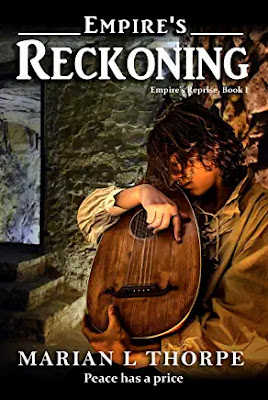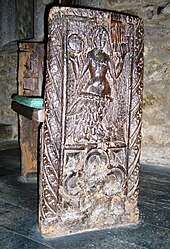 |
visiting around and about,
wandering here and there...
|
Dunadd
 |
Dunadd Hillfort: Otter, CC BY-SA 3.0
(via Wikimnedia) |
About 50 kilometers south of Oban, on the west coast of Scotland, a low, rocky hill rises in a series of natural terraces. Not a very high hill: only 54 m – and yet an important hill, in both history and my life.
In the early 80s, both my husband and myself were graduate students at a university with a Scottish Studies department. We were not members of this department, but we were both interested in history, and the course Early Scottish History was offered in the evenings through Continuing Education. We signed up. The lecturer was a Scot, Ted Cowan, newly moved to Canada to teach in this department, and a born storyteller.
One of the many stories he told was of Dunadd, the stronghold of the kings of Dál Riata, with the boar and the footprint carved into the rock. How the man who would be king had to place his foot in that print, up under the sky on the hilltop, his lands below.
 |
Boar carving: Johnragla, CC BY-SA 3.0
(via Wikimedia) |
In 1986, we’d saved enough money for a delayed honeymoon, and we were both defending our theses in October. A holiday beforehand seemed like a good idea. So we found a charter flight (remember those?) to Scotland and flew for the first time as a couple across the Atlantic, landing at Prestwick in the early morning. The first few days we spent visiting relations, and then we were free.
Dunadd must have been one of the first places we went: I no longer remember. I remember parking, and climbing up the path past the white house at the base on a partly sunny and windy day. I remember the rolling fields below us, and the river. We looked at the carved boar, and the footprint, and I placed my foot in that petrosomatoglyph* (and in 1986, I think it might still have been the real one, and not the replica that is there now) and a shock of ‘what did I just do?’ ran through me.
And at that moment, although I could not have defined it at the time, landscape and history and legend and story became something more than the sum of their parts. Ted’s stories weren’t just entertaining tales; they were rooted in this land, this hill, and these carved symbols that had been here for fifteen hundred years or longer. A kingdom that had risen, and flourished, and fallen, but was not forgotten, its marks still on the land, its traces still in blood and language and memory.
In my fifth book, Empire’s Reckoning, young Gwenna is with her teacher Sorley, on his family’s land.
“But you still love it here.” She shook her head in frustration. “That’s not right. More than love, but I don’t know how to say it.”
“Dùthcas.” She looked up at me quizzically. “I can’t translate it,” I said. “Belonging is close. It’s as if I carry this place deep inside me, and I hear it calling to me, always.”
From that moment on the summit of Dunadd to the world of my books there is a line. Not a straight one: my fictional world has many influences, but what I write about, at its heart, is the intersection of landscape and history and story, and the way language and memory and place hold people – and those themes moved from abstract to, at some visceral level, understood, that September morning thirty-five years past. And although it’s never come up in the story, I rather think that the Teannasacha of Linrathe, the chosen chieftains of the land north of the Wall, are acknowledged in their authority on a hill with a carved boar and a footprint in the rock, the sky above them and their land spread out below.
*petrosomatoglyph is the posh name for any body part carved into stone.
How many secrets can one family have?
For 13 years, Sorley has taught music alongside the man he loves, war and betrayal nearly forgotten. But behind their calm and ordered life, there are hidden truths. When a young girl’s question demands an answer, does he break the most important oath he has ever sworn by lying – or tell the truth, risking the destruction of both his family and a fragile political alliance? Empire’s Reckoning asks if love – of country, of an individual, of family – can be enough to leave behind the expectations of history and culture, and to chart a way to peace.
Book of the Year, Historical Fantasy 2020, The Coffee Pot Book Club Historical Fiction Awards
* * * * * *
Helen's Latest Release
 |
A new edition with new additional scenes |
When the only choice is to run, where do you run to?
When the only sound is the song of the sea, do you listen?
Or do you drown in the embrace of a mermaid?
Throughout childhood, Jesamiah Mereno has suffered the bullying of his elder half-brother. Then, not quite fifteen years old, and on the day they bury their father, Jesamiah hits back. In consequence, he flees his Virginia home, changes his name to Jesamiah Acorne, and joins the crew of his father’s seafaring friend, Captain Malachias Taylor, aboard the privateer, Mermaid.
He makes enemies, sees the ghost of his father, wonders who is the Cornish girl he hears in his mind – and tries to avoid the beguiling lure of a sensuous mermaid...
An early coming-of-age tale of the young Jesamiah Acorne, set in the years before he becomes a pirate and Captain of the Sea Witch.
“I really enjoyed the insight offered into Jesamiah's backstory, and found the depiction of our teenage hero very moving.” Anna Belfrage, author
*** ***
Helen's cosy mystery set in 1970s north London
Eighteen-year-old library assistant Jan Christopher’s life is to change
on a rainy Friday evening in July 1971, when her legal guardian and uncle, DCI
Toby Christopher, gives her a lift home after work. Driving the car, is her
uncle’s new Detective Constable, Laurie Walker – and it is love at first sight
for the young couple.
But romance is soon to take a back seat when a baby boy is taken from
his pram, a naked man is scaring young
ladies in nearby Epping Forest, and an elderly lady is found, brutally
murdered...
Are the events related? How will they affect the staff and public of the
local library where Jan works – and will a blossoming romance survive a police
investigation into murder?
“Lots of nostalgic, well-researched, detail about life in the 1970s,
which readers of a certain age will lap up; plus some wonderful, and
occasionally hilarious, ‘behind the counter’ scenes of working in a public
library, which any previous or present-day library assistant will recognise!” Reader
Review
< PREVIOUS POST





































